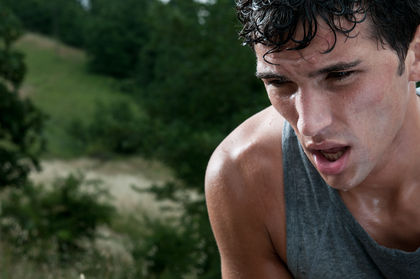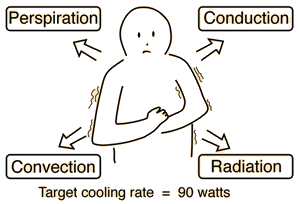Physical fatigue or muscle weakness and/or aches, (or "lack of strength") is a direct term for the inability to exert force with one's muscles to the degree that would be expected given the individual's general physical fitness. A test of strength is often used during a diagnosis of a muscular disorder before the etiology can be identified. Such etiology depends on the type of muscle weakness, which can be true or perceived as well as central or peripheral. True weakness is substantial, while perceived weakness is a sensation of having to put more effort to do the same task. Central muscle weakness is an overall exhaustion of the whole body, while peripheral weakness is an exhaustion of individual muscles.
Fatigue is a normal result of working, mental stress, overstimulation and under stimulation, jet lag or active recreation, depression, and also boredom, disease and lack of sleep. It may also have chemical causes, such as poisoning or mineral or vitamin deficiencies. Massive blood loss frequently results in fatigue. Fatigue is different from drowsiness, where a patient feels that sleep is required. Fatigue is a normal response to physical exertion or stress, but can also be a sign of a physical disorder.
The temperature-regulation research of Stanford biologists H. Craig Heller and Dennis Grahn has led to a device that rapidly cools body temperature, greatly improves exercise recovery, and could help explain why muscles get tired. Stanford biology researcher Dennis Grahn, seems bemused. "We really stumbled on this by accident," he said. "We wanted to get a model for studying heat dissipation."
But for more than a decade now, Grahn and biology Professor H. Craig Heller have been pursuing a serendipitous find by taking advantage of specialized heat-transfer veins in the palms of hands, they can rapidly cool athletes' core temperatures – and dramatically improve exercise recovery and performance.
In humans, AVAs show up in several places, including the face and feet, but the researchers' glove targets our most prominent radiator structures – in the palms of our hands. The newest version of the device is a rigid plastic mitt, attached by a hose to what looks like a portable cooler. When Grahn sticks his hand in the airtight glove, the device creates a slight vacuum. The veins in the palm expand, drawing blood into the AVAs, where it is rapidly cooled by water circulating through the glove's plastic lining. The method is more convenient than, say, full-body submersion in ice water, and avoids the pitfalls of other rapid palm-cooling strategies. Because blood flow to the AVAs can be nearly shut off in cold weather, making the hand too cold will have almost no effect on core temperature. Cooling, Grahn says, is therefore a delicate balance.
Even in prototype form, the researchers' device proved enormously efficient at altering body temperature. The glove's early successes were actually in increasing the core temperature of surgery patients recovering from anesthesia. "We built a silly device, took it over to the recovery room and, lo and behold, it worked beyond our wildest imaginations," Heller explained. "Whereas it was taking them hours to re-warm patients coming into the recovery room, we were doing it in eight, nine minutes."
But the glove's effects on athletic performance didn't become apparent until the researchers began using the glove to cool a member of the lab – the confessed "gym rat" and frequent coauthor Vinh Cao – between sets of pull-ups. The glove seemed to nearly erase his muscle fatigue; after multiple rounds, cooling allowed him to do just as many pull-ups as he did the first time around. So the researchers started cooling him after every other set of pull-ups.
The researchers applied the cooling method to other types of exercise – bench press, running, cycling. In every case, rates of gain in recovery were dramatic, without any evidence of the body being damaged by overwork – hence the "better than steroids" claim. Versions of the glove have since been adopted by the Stanford football and track and field teams, as well as other college athletics programs, the San Francisco 49ers, the Oakland Raiders and Manchester United soccer club.
Much of the lab's recent research can be summed up with Grahn's statement that "temperature is a primary limiting factor for performance." But the researchers were at a loss to understand why until recently.
In 2009, it was discovered that muscle pyruvate kinase, or MPK, an enzyme that muscles need in order to generate chemical energy, was highly temperature- sensitive. At normal body temperature, the enzyme is active – but as temperatures rise, some of the enzyme begins to deform into the inactive state. By the time muscle temperatures near 104 degrees Fahrenheit, MPK activity completely shuts down. There's a very good biological reason for this shutdown. As a muscle cell increases its activity, it heats up. But if this process continues for too long, the cell will self-destruct. By shutting itself down below a critical temperature threshold, MPK serves as an elegant self-regulation system for the muscle. "Your muscle cells are saying, "You can't work that hard anymore, because if you do you're going to cook and die,'" Grahn said. When you cool the muscle cell, you return the enzyme to the active state, essentially resetting the muscle's state of fatigue.The version of the device that will be made available commercially is still being tweaked, but the researchers see applications for heat extraction in areas more important than a simple performance boost. Hyperthermia and heat stress don't just lead to fatigue – they can become medical emergencies.







No comments:
Post a Comment